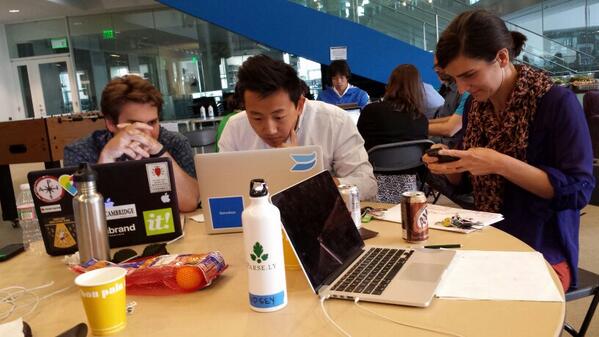Hacking The News
A Sunday morning in the MIT Media Lab atrium, all the clues were there. Few words spoken between huddled teams. Quiet determination encoded in methodical keystrokes. Yes, a hackathon was entering its final hours.
Hacking Journalism, a hackathon hosted by Embed.ly & MIT’s Media Lab brought together journalists, students and technologists to hunt for solutions to familiar problems in digital journalism. How do you find new ways to tell a story? How do you determine what is relevant and true in a world of noise? How do you figure out who will reveal the next detail of a story as it unfolds?

Everyday we see our clients dealing with the evolving nature of digital storytelling, and we’re always looking for ways to help them better negotiate those challenges. We came to this event prepared with Parse.ly API examples and sample data from our client www.greentechmedia.com. I was there not only to represent Parse.ly as our Developer Evangelist, but also to collaborate on the projects and write some code!
All told, over 100 participants including reps from the Guardian, The Boston Globe, Twitter, MIT Technology Review and more demonstrated 16 hacks. Each illuminated a different facet of the future of news creation and consumption. One of the crowd’s favorites was Newstrition, which seeks to help consumers understand their information “diet”. This hack was implemented as a Google Chrome extension.
Twitter / garrettwilkin: Newstrition helps you understand …
Newstrition attempts to classify each news website in your browser history and then uses that information to answer questions like: How much politics are you reading? Are you binging on celebrity gossip again? How many articles have you read from Hacker News today? Perhaps you should spend a little more time in the international news section.
This hack sought to take a data driven approach to helping individuals make more intentional choices about the media they consume. What’s interesting about this problem is the role that publishers could play. By adopting structured data formats to classify and describe their content, these types of hacks would become easier to implement. This team executed the idea in true hackathon style and shared the project via an open source repository on GitHub.
Aleszu Bajak, a journalist and developer, came away with a special prize – best use of the Parse.ly API. He created a prototype of new visualizations in just a few hours. We make an effort to make sure our API and platform is clear and accessible, and it was fun to watch Bajak bring that to life.
Twitter / garrettwilkin: Meet @aleszubajak the talented …
The downside to hackathons, of course, is that they end in one weekend, while the problems in the world of online journalism still need to be solved. The crowd was well aware of the issues they would have to go back and face in their day-to-day lives.
One recurring frustration we heard from independent journalists and freelance writers was the desire to understand their audience’s engagement with their work, and the roadblocks that stopped that from happening. Complaints included delays of manual requests and the lack of access to internal resources. I was happy to let them know about Parse.ly’s capabilities, but there’s plenty of questions out there that still need to be answered.
As innovators experiment with new ways to extract, collect, generate, and present content, how can existing publishers participate? Could providing post metadata facilitate the next news consumption app? Would allowing developers to select top performing content lead to increased referrer traffic? We can’t say for certain, but we’re excited to be a part of the community that is working to find out.